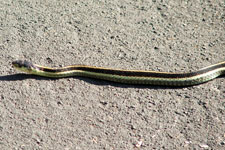Local Wildlife
Northwestern Garter Snake

Scientific Name: Thamnophis ordinoides
More Info: Univ. of Michigan
The northwestern garter snake and its close cousins are, perhaps, the most widely found snakes in North America. They can grow as long as two feet, but are more often 14 to 18 inches in length. The upper body is black or nearly black while the underside is a mottled yellow-cream. One stripe runs along the back (often called the dorsal stripe) in addition to a stripe down each side. These stripes are generally yellow or off-white, but both the stripes and overall coloring can differ noticably between individual snakes.
Garter snakes are carnivorous and non-discriminate, eating virtually any small animal they are able to capture including insects, caterpillars, small lizards, worms, slugs, frogs, and even the occassional small bird, fish, or rodent (though this is less common). Fitted only with fangs, garter snakes do not chew, but swallow their food whole instead. Though they prefer live prey, if food is scarce they may resort to eating eggs or carrion.
When startled or disturbed, a garter snake may strike, but this is a rare and unusual occurrance. In general they prefer to simply avoid humans and, as a result, are not often seen. In Sunriver, the best time to view them is in the morning when they can be found warming themselves in the sun on a flat surface such as a bike path. When the temperature is high, they will duck into thickets, wood piles, or heavy brush to take a rest in the shade. On cold nights, several garter snakes may sleep together in a protected area to help maintain their body temperature. Likewise, during hibernation these snakes will sleep in large communal nests called hibernacula.
Garter snakes begin mating shortly after coming out of hibernation and males will do so with several different females. The male sends out pheromones that attract females who follow the scent and, if the male is considered suitable, mate with him. Once impregnated, a female will begin searching for food and a place to give birth. After two to three months, the female gives birth to a single litter that can range in size from three to fifty babies. These offspring are independent at birth and the mother and babies do not remain together.
